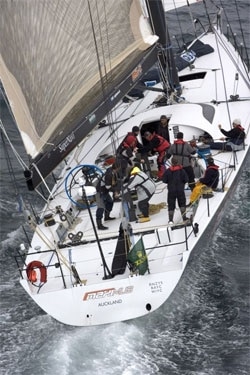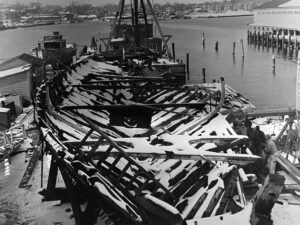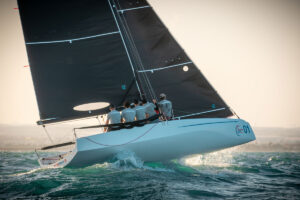
Maximus GP Launches
With a name like Maximus, you would expect this Greg Elliott-Clay Oliver collaboration to be bigger than any grand-prix design ever built. When you learn that its carbon hull is merely 98 feet in length, you realize-yawn-it’s just another supermaxi, and of course, it has the de riguer canting keel and aspirations to win the Sydney Hobart Race. But talk to owners Charles St. Clair Brown and Bill Buckley, and you’ll find that behind that grand name are grand aspirations. We could call their attempt a Super Maxi Grand Slam-not the mere four victories you’d need for a simple slam, but double that: The Rolex Transatlantic, Rolex Giraglia, Round Gotland, Skandia Cowes Week, Rolex Fastnet, Rolex Middle Sea, Maxi Yacht Rolex Cup, and Rolex Sydney Hobart Race. Along the way, they plan to set a Transatlantic race record and break the monohull 24-hour record. (What’ll they do for an encore in 2006?) On closer inspection, Brown and Buckley (a.k.a. EBS Yachting) do have a few tricks up their sleeves. First of all, Brown is a former Tornado racer, so it’s no surprise this boat is designed for maximum righting moment (like a cat) and high sail-area-to-displacement ratio (like a cat). It’ll get up to speed quickly, and he says they won’t be shy to reef if need be. And there’s another thing that’s even more cat like-and completely novel for a super maxi-a rotating mast. While common on multihulls, these are relatively few and far between on monohulls, which have a narrower shroud base to keep them upright. Southern Spars’ Martin McElwee says they needed to trick the mast into thinking it had a wide base, and to do so, they used long spreaders. To make this work, McElwee says each spreader is fixed to the mast by a single pivot point (see drawing), and the inboard ends pivot against the side of the mast as it rotates. This has already worked on Mike Golding’s Ecover and Aldo Pagani’s Mister A (“Grand Prix Launches,” May ’05), but Maximus’s mast (123’6″) is the tallest rotating rig Southern’s built yet, and so for the first time they’ve set it up with double spreaders. To make things one degree more challenging, the ball on which the mast sits and rotates is also designed to lead the halyards out of the mast and then along the deck. And because-should you need just a little more shroud tension-you’d never find a couple of wrenches long enough to work the turnbuckles, this rig has an hydraulic mast jack under the ball to push the whole rig up and tension the shrouds when needed. The shrouds are state of the art, too, made of continuously wound PBO fiber, supplied by Future Fibres in the UK. Not to be outdone by his partner, Buckley put his company, Buckley Systems Limited, to work engineering and building the canting keel. They’ve focused on doing a better job on the mechanics and back-up systems than other maxis (e.g. Skandia, which lost its keel and turned turtle in the last Hobart race), and he’s arranged for a low-profile mechanism, all of it below the cabin sole (“According To Bill Buckley,” April ’05). The keel’s nearly 20-foot draft provides great leverage, but seemed a little extreme for your average docking area, so Buckley upped the ante by hollowing out the upper part of the keel fin so the lower part could hydraulically retract inside it by more than 6 feet.. Most canting-keel designs have a daggerboard or canard in front of the keel, or they’ve gone with the patented CBTF configuration, using a forward rudder (“Full Tilt Maxis, April ’04). This Greg Elliott design finds a new middle road by adding a small trim tab to the forward canard. Believe it or not, while keeping Elliott (co-designer of Mari Cha IV) on his toes making sense of the rig, appendages, and boat, and commissioning extensive VPP work by Clay Oliver, and then building the boat at Cookson Boats, the owners remembered to order sails, which in round figures are 500 square-meters upwind and 800 downwind. The asymmetric chutes fly off a fixed 10-foot sprit. At press time, Maximus was on a ship bound for Antigua, but the ship was having engine troubles, so Antigua Race Week had to be scratched. Once rigged, Maximus will head north for New York in early May, hopefully in time for the Transatlantic. We’ll be following this one and are wondering if the Gladiator himself, Russell Crowe, might appear to help Brown out on the helm for the first race. More likely, as they sheet in against Mari Cha IV on the first leg of their Super Maxi Slam, they ought to bring along the other Russell-the currently unemployed Russell Coutts.









